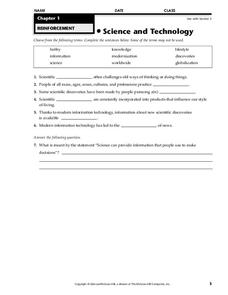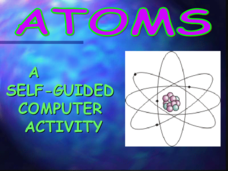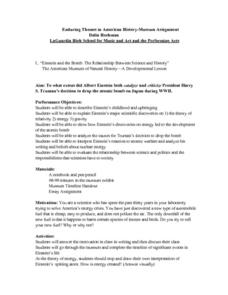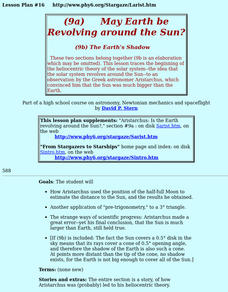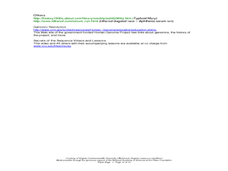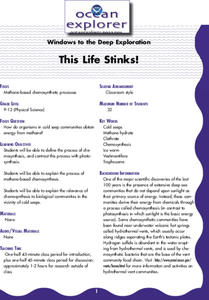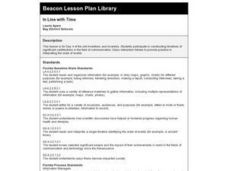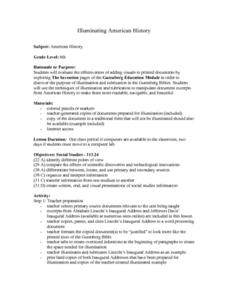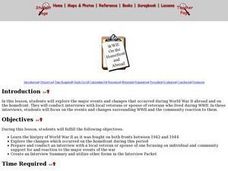Curated OER
Science and Technology
In this science technology worksheet, students will complete 6 fill in the blank questions based on how modern technology has led to advances in science.
Curated OER
Invertebrate Classification
High schoolers discuss the recent disovery of the "furry lobster" to peak interest in the animal kingdom. They classify various speciments using invertebrate dichotomous keys, identifying major animal phyla and classes. Thy the complete...
Curated OER
World War II Webquest
Tenth graders work with a partner to locate and follow the directions of a webquest of their choice. Using the internet, they research their topic in depth and write a paper on their findings. They are assessed by the criteria on the...
Curated OER
Atoms : A Self Guided Computer Activity
"Self-guided Computer Activity" simply means that young chemists read through the slides and take notes about atoms along the way. There is an abundance of text on each slide, making this a comprehensive introduction to atomic structure....
Curated OER
Weather Proverbs
Students investigate various concepts related to weather. They conduct historical research to see how the study of weather originated and the application of the latest technologies in the field. Students summarize the information with...
Curated OER
What's Cookin' at Honey Creek?
Fourth graders are introduced to the process of prehistoric hot rock cooking in earth ovens on the Edwards Plateau of Texas. They explain the steps used in the hot rock cooking process.
Curated OER
Exhibiting Your Knowledge
Learners are introduced to the various museum functions. In groups, they create a traveling exhibition based on Gutenberg's invention and the first printed book. They share their exhibition with the class and answer any questions presented.
Curated OER
What's The Big Deal?
Fifth graders examine the role of the Gutenberg press and its effect on society. Using this information, they write a persuasive paper discussing which form of copying is easier to mass produce. They share their opinions with the class...
Curated OER
Where Did It Begin?
Students work together to research the oldest forms of writing in the world and the materials used to create them. They explore the cultures that used this early form of writing and draw conclusions about why specific symbols were used....
Curated OER
The Hope of Science: DNA Practical Applications Time Line
Students design a time line to inform and educate people about the history of DNA practical applications.
Curated OER
National Museum of the Pacific War
Students examine the role of science and technology in World War II. They discover how some inventions have changed to meet society's need after the war was over. They visit the museum to complete the lesson.
Curated OER
Enduring Themes in American History-Museum Assignment
Students study and research the life of Albert Einstein. They focus on the extent Albert Einstein catalyzed and criticized President Harry S. Truman's decision to drop the atomic bomb on Japan during WWII. Students answer a series of...
Curated OER
Goobers. Goobers? Goobers!
Students begin the lesson by noting the many ways in which to use peanuts. In groups, they use the internet to research the work of George Washington Carver. They discover the allergies and nutritional information of the peanut and...
Curated OER
May The Earth Be Revolving Around The Sun?
Students trace the beginning of the heliocentric theory of the solar system--the idea that the solar system revolves around the Sun--to an observation by the Greek astronomer Aristarchus, which convinced him that the Sun was much bigger...
Curated OER
May Earth be Revolving around the Sun?
Ninth graders explore how Aristarchus used the position of the half-full Moon to estimate the distance to the Sun, and how he made a great error, but still figured out that the Sun is much larger than Earth.
Curated OER
The Secrets of the Sequence
Students explore genetics using a series of selected videos. For this biology lesson series, students study the different advances in life sciences. They research the pros and cons of genetic research.
Curated OER
The Five Senses
Study various objects and help kindergarteners use their five senses to classify the objects. They are presented with various objects and then use their five senses to sort and classify the objects. Then they use a Visual Ranking Tool to...
Curated OER
This Life Stinks!
Pupils explore the process of chemosynthesis and contrast this process with photosynthesis. They consider the relevance of chemosynthesis to biological communities in the vicinity of cold seeps.
Curated OER
In Line with Time
Third graders create a timeline of inventions and inventors made out of light colored bulletin board paper.
Curated OER
Back Up
Third graders participate in a review game about significant people who have made inventions.
Curated OER
The Accident That Did Not Happen
Middle schoolers examine science lab equipment and review the basic rules of laboratory skills.
Curated OER
Illuminating American History
Eighth graders evaluate the effectiveness of adding visuals to printed documents by exploring "The Invention" pages of the "Gutenberg Education Module". They use the techniques of illumination and rubrication to manipulate documents from...
Curated OER
The Study of the Spanish-Speaking People of Texas: Daily Life
Young scholars analyze the different ways that photography helps historians understand the lives of people who lived in the past. They examine images from Russell Lee's photo essay and discuss how Texas' has changed from an agrarian to...
Curated OER
WWII: On The Homefront and Abroad
Students explore World War II from the perspective of both the sides. They research the changes that occurred on the homefront during 1942-1944. Students prepare and conduct an interview with a local veteran or spouse of a veteran...
